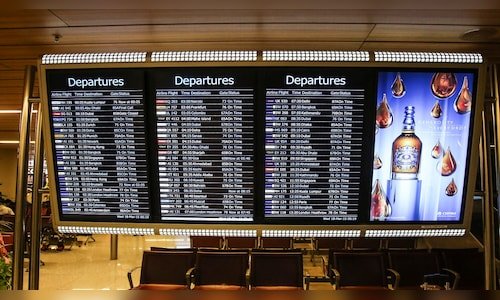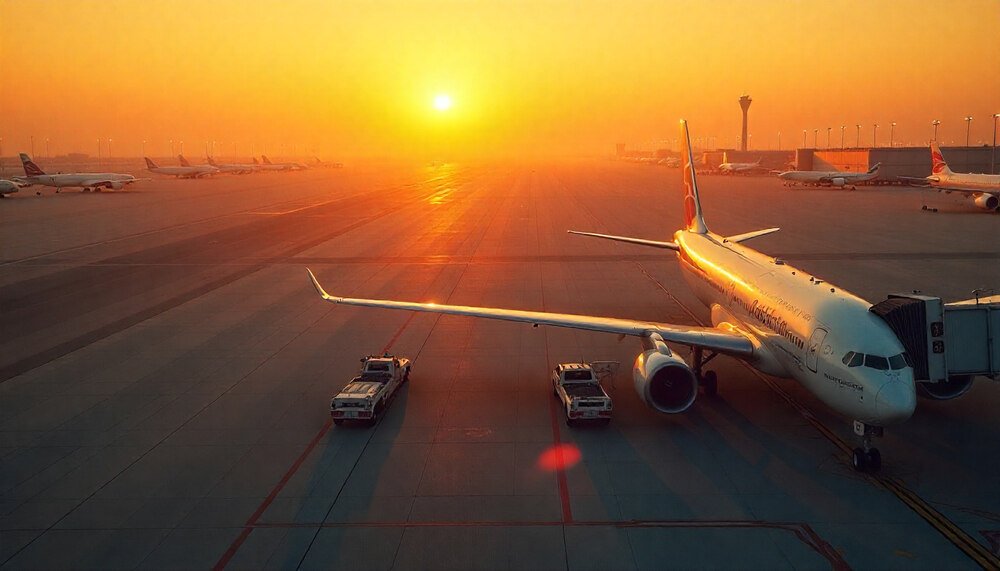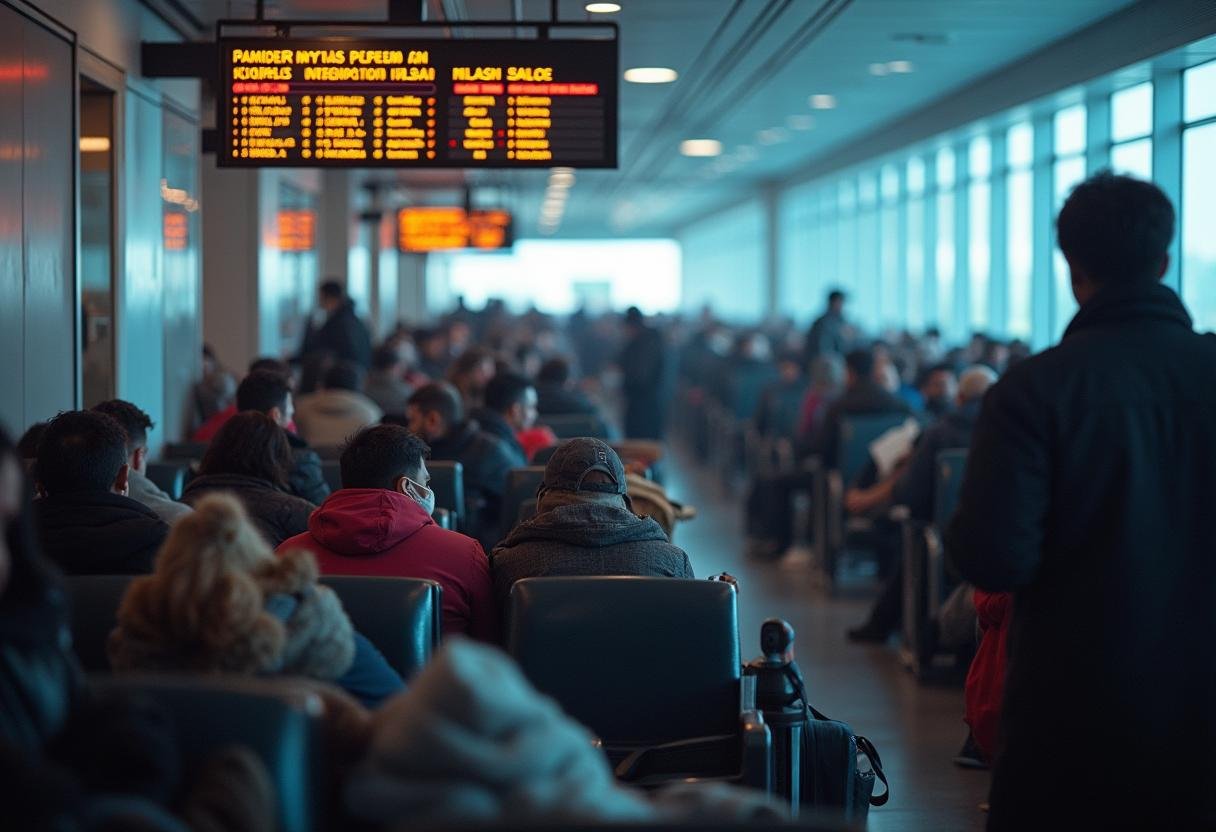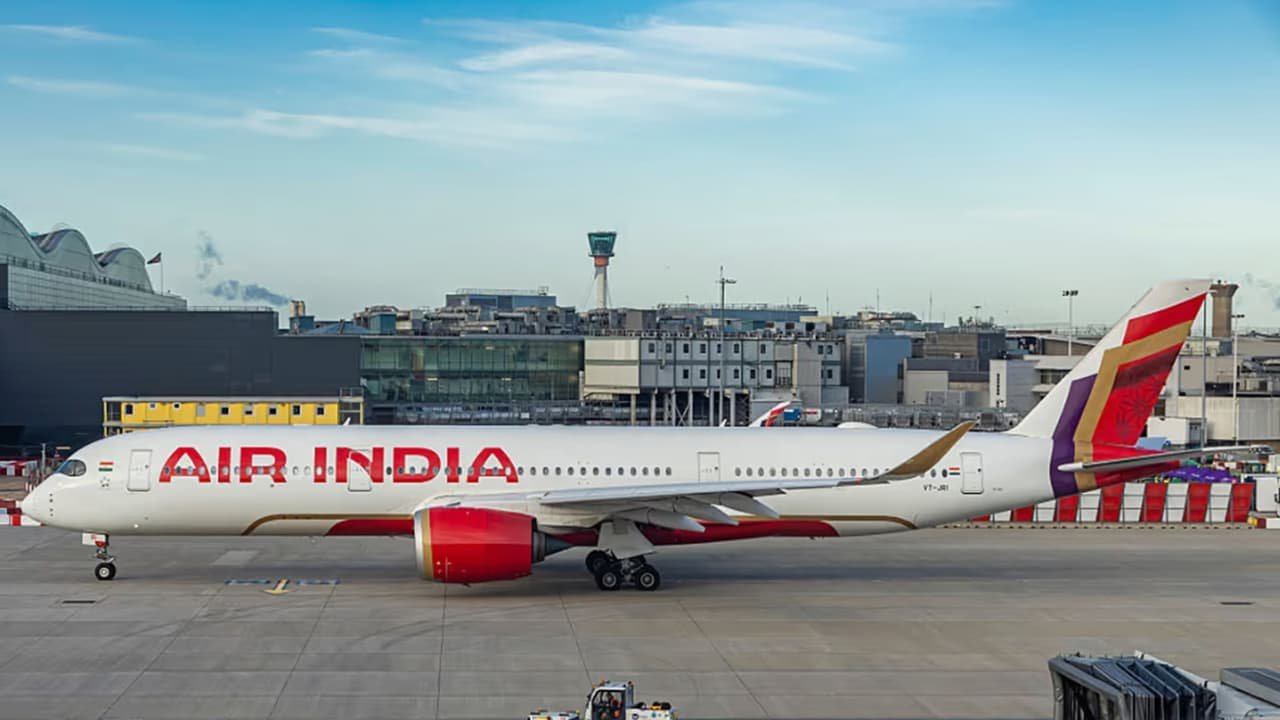Flight Buzz
Mumbai Airport: Technical glitch disrupts check-in systems, several flights delayed

Although the affected systems have now been restored, Air India reported that some of its services continued to face delays as operations gradually returned to normal.
Also read | Delhi rains: Airlines issue travel advisory at Delhi Airport amid flight delays, cancellations
The airline said, “A third-party data network outage had impacted check-in systems at Mumbai airport, thereby delaying flight departures of airlines, including Air India. The systems have since been restored, however, some of our flights may continue to be affected for some time as the situation normalises progressively.”
#TravelAdvisory
A third-party data network outage had impacted check-in systems at Mumbai airport, thereby delaying flight departures of airlines, including Air India. The systems have since been restored, however, some of our flights may continue to be affected for some time as…
— Air India (@airindia) August 9, 2025
In response to a passenger’s concern, Mumbai airport authorities confirmed the issue and stated that emergency protocols were immediately put into effect to manage the disruption. The airport posted a message on X saying, “We would like to inform you that we’re currently facing a network failure across the airport. We’ve activated contingencies and are working on resolving the issue with our core team. We’re operating in manual mode to minimize disruptions. We appreciate your patience in this regard. Team CSMIA.”
The incident led to a temporary switch to manual check-in procedures as teams worked to resolve the network failure. While normal operations have resumed, passengers were advised to stay updated with their respective airlines for real-time information regarding their flights.
(Edited by : Jerome Anthony)
Flight Buzz
Saudi Arabia Sets Revolutionary Aviation Benchmarks During Hajj 2025, Efficiently Handling Over 140,000 Flights in a Brilliant Display of Operational Mastery

Published on
August 9, 2025 |
Saudi Arabia has achieved an extraordinary feat during Hajj 2025, shattering global air traffic records by managing over 140,000 flights, marking a groundbreaking 8% increase from the previous year. The Kingdom orchestrated a seamless flow of air traffic, effectively handling a monumental number of domestic and international flights, underscoring its dominance in global aviation. This remarkable achievement highlights Saudi Arabia’s unmatched precision and operational excellence in facilitating one of the largest annual religious events in the world. With a record 2,338 air movements in a single day, the Kingdom has set new standards in air traffic management, solidifying its leadership as a vital global aviation hub. Through strategic planning and cutting-edge technology, Saudi Arabia has demonstrated its unwavering commitment to ensuring a safe, smooth, and efficient pilgrimage experience for millions of Muslims worldwide.
Saudi Arabia achieved a historic milestone during the 2025 Hajj season, successfully managing over 140,000 air movements, marking an 8% increase compared to the previous year. This remarkable feat highlights the Kingdom’s commitment to streamlining logistics and enhancing air traffic operations, ensuring a smooth pilgrimage experience for millions of Muslims worldwide.
A Surge in Air Traffic
The 2025 Hajj season (Hajj 1446 AH) witnessed record-breaking air traffic, with more than 140,000 flights handled by Saudi Arabia’s airspace. These flights consisted of both domestic and international air movements, underlining the Kingdom’s essential role in facilitating the pilgrimage. The Saudi Air Navigation Services (SANS) coordinated air traffic for 213 airlines, further reinforcing Saudi Arabia’s global connectivity and importance as a key aviation hub for religious tourism.
Key Highlights of Air Traffic Operations
- Single-Day Peak: On Dhu Al-Hijjah 2, 1446 AH, Saudi Arabia achieved a new record for air traffic, with 2,338 aircraft movements in a single day. This marked a 4% increase over the same day in 2024, showcasing the Kingdom’s growing air traffic capacity.
- Arrival and Departure Phases:
- Arrival Phase: During the period from Dhu Al-Qidah 1 to Dhu Al-Hijjah 8, there were 74,902 air movements, representing a 15% increase over the previous year. This reflects a significant surge in the number of incoming flights as millions of pilgrims arrived in the Kingdom for Hajj.
- Departure Phase: From Dhu Al-Hijjah 23 to Muharram 15, Saudi Arabia recorded 66,072 air movements during the departure phase, showing a 2% increase compared to 2024.
These figures demonstrate the Kingdom’s ability to handle substantial air traffic volume, with arrivals seeing a particularly impressive increase in comparison to the previous year.
Advanced Operational Strategies and Technology
The success of Saudi Arabia’s air traffic management during Hajj 2025 can be attributed to advanced technological infrastructure and highly skilled personnel. The Saudi Air Navigation Services company (SANS) deployed sophisticated air traffic management systems, ensuring seamless operations despite the high volume of air movements. This technological infrastructure was paired with highly trained air traffic controllers, engineers, and maintenance teams, all working together to ensure the safety and efficiency of each flight.
Furthermore, Saudi Arabia’s airspace management allowed for smooth and coordinated air traffic flows across all major airports in the Kingdom, facilitating the swift and safe arrival and departure of millions of pilgrims from various parts of the globe.
Saudi Arabia’s Growing Role in Global Aviation
The record air traffic numbers during the Hajj season also reflect Saudi Arabia’s growing role in global aviation. By coordinating with 213 international airlines, the Kingdom further established itself as a central hub for international air travel. This broad international participation underscores Saudi Arabia’s increasing influence in global aviation, making it a key gateway for pilgrims from around the world.
As the Kingdom’s aviation infrastructure continues to improve, Saudi Arabia’s connectivity to global airlines grows stronger, expanding its reach as a leading air transport hub. The Kingdom’s strategic location between continents also plays a pivotal role in facilitating smooth air traffic operations, benefiting both religious pilgrims and international travelers.
Ensuring a Seamless Pilgrimage Experience
At its core, the success of Saudi Arabia’s air traffic management during Hajj 2025 is driven by the Kingdom’s commitment to providing a safe, smooth, and efficient pilgrimage experience for Muslims worldwide. The 140,000 flights, including the record-breaking 2,338 aircraft movements in a single day, demonstrate Saudi Arabia’s preparedness and capacity to handle large-scale religious events.
The operational excellence displayed during the Hajj season not only benefits the logistics of the pilgrimage but also contributes to the spiritual journey of millions. The efficient air traffic flow ensures that pilgrims can focus on their religious duties without concerns about travel-related disruptions.
Looking Ahead: Preparing for Future Hajj Seasons
The remarkable success of Hajj 2025 sets a new benchmark for the Kingdom in terms of air traffic management. As Saudi Arabia continues to modernize its air navigation systems and infrastructure, it is poised to handle even greater volumes of traffic in future seasons.
The strategic role of Saudi Arabia in global air traffic will continue to grow as the Kingdom enhances its international partnerships with airlines and expands its technological capabilities. With future Hajj seasons expected to draw even more pilgrims, Saudi Arabia’s ability to manage air traffic efficiently will be crucial to ensuring the safety and success of the pilgrimage.
In conclusion, Saudi Arabia’s achievement in handling over 140,000 flights during Hajj 2025 not only showcases its operational excellence but also underscores the Kingdom’s importance as a global hub for air travel. The continued development of Saudi Arabia’s aviation infrastructure will only further cement its position as a leader in religious tourism and international air connectivity.
Flight Buzz
More Than Three Hundred Flights Delayed At Delhi Airport Due To Severe Weather

Published on
August 9, 2025 |
New Delhi had to deal with a major disruption to travel as Indira Gandhi International Airport had more than 300 flights delayed due to the bad weather. The national capital region experienced heavy rain along with thunderstorms, lightning, as well as strong winds, which caused a big impact on both ground and aerial transport. With the India Meteorological Department (IMD) issuing weather warnings, the storm caused a lot of trouble for both locals and tourists.
Arriving and departing passengers flying to and from Delhi Airport had to deal with long delays of their flights as a result of bad weather conditions. Although the airport tried to operate normally, the bad weather made it impossible to maintain normal schedules, which led to cascading delays throughout the day.
Widespread Disruption Due to Extreme Weather
The heavy rain started late at night and then continued the next morning, with thunderstorms along with lightning adding to the chaos. Flight tracking services like Flightradar24 reported hundreds of flights being delayed due to rain, strong winds, and the combination of unstable weather.
As the weather conditions deteriorated, the IMD issued a rain alert for the city, forecasting moderate rain, thunderstorms, and winds between 30-40 km/h. The department also issued an alert concerning critical Safety guidelines, recommending people skip outdoor activities during the storm. The IMD, as is the norm, posted reminders telling people to be careful while driving, secure loose articles lying around on balconies and rooftops, and refrain from standing under trees during lightning due to the risk of a bolt falling during the storm surge.
The weather-related events, although not heavily impacting the Delhi Airport, at the very least resulted in several flights not being able to take off, land, or be on schedule. Weather-related disruptions cascaded in a domino effect throughout the day, forcing wait times for most travelers.
Effect on Surface Transportation and Day-to-Day Activities
Apart from the air travel disruption, the storm-affected areas extended well beyond the airport. Overnight rainfall in the Delhi-NCR region, and Panchkuian Marg, Mathura Road, and Connaught Place, resulted in waterlogging. The waterlogged areas brought about terrible traffic congestion, and added to the already overburdened delays on the arterial highways, and resulted in delays for a plethora of travelers looking to navigate the city.
Locals took action by issuing home travel advisories, asking people to stay home if possible, and to minimize travel. For people who needed to leave the house, traveling through the flooded streets was difficult. Roads being flooded with rain brought the usual city noise to a standstill, which added to the agony of commuters.
Airlines Respond with Travel Advisories
Due to the weather conditions, some airlines issued advisories for passengers to help them navigate through the disruption. One of the major airlines operating out of Delhi, IndiGo, and SpiceJet, informed passengers through their social media accounts about the delays. Both airlines advised travelers to monitor the flights and adjust their travel plans as conditions worsened.
Air India was also warning travelers with a message saying the heavy rain may affect flight operations to and from Delhi. Air India was also recommending passengers to modify their plans early, as the flights and the traffic were expected to create some congestion. In spite of the disruption, the airline was focused on operational and safety efficiency for passengers during the storm.
Such proactive communication helped passengers manage their travel plans because they did not have to show up at the airport and deal with unnecessary waiting. Many travelers, for the most part, adapted to the changes, even if it meant arriving much earlier than they had originally planned.
The Situation at the Delhi Airport
Due to the extensive delays caused by the weather, the Delhi Airport continues to remain operational. To the general public, “everything was normal.” As for the airport, “normal flight operations” meant that a substantial number of flights were still being delayed. Staff were doing their utmost to streamline the essential security and boarding procedures, but the large number of delayed flights was a significant bottleneck.
In a press release, the airport’s official representative acknowledged that flight operations were continuing but advised passengers to coordinate with their respective airlines for the most current flight schedules. Alongside that, the representative added that the airport was actively trying to work with the airline’s weather-related restrictions to limit the consequences of the bad weather on flights that were meant to take off.
Even though flights were still operating, passengers were experiencing severe disruptions to their journeys due to the weather. The delays to flights arriving and departing were resulting in very long lines at the check-in counters, and customers were often left guessing as to whether their flights were going to be further delayed or canceled altogether.
IMD Issues Red Alert for Delhi
The IMD was continuously monitoring the situation and issued a red alert, meaning moderate to heavy rain was still expected for the rest of the weekend. The IMD advised the public to remain vigilant and stay out of the band of additional weather disruptions that were expected.
Local Weather authorities also warned and restricted of the creeping flooding, especially in the low-lying areas, advising people to cease all non-essential movement. Delhi has a long history of heavy rain towards the end of the tapering monsoon season, but the sheer power of this storm was astonishing, especially as it showcased the unpredictability of the region’s weather.
Conclusion
The memories from August 9, 2025, still linger, serving as a pertinent reminder of how disruptive weather can be to both air and ground travel. The storm single-handedly brought the capital to a standstill, with over 300 flights being delayed at the Delhi Airport, and the heavy rains disrupting daily activities. Airlines, the IMD, and local authorities collaborated to manage the situation, and while their efforts to keep the public informed were noted, the disruption itself was unavoidable.
As the weekend approaches, both travelers and residents alike are being warned to stay vigilant and keep track of weather updates. For travelers passing through Delhi, the storm was certainly a reminder of how critical planning, preemptive measures, and being flexible can be when dealing with weather-related events.
(Source: India Meteorological Department, Delhi Airport, Flightradar24, IANS)
Flight Buzz
Flights Delayed at Mumbai Airport After Network Outage, Air India Issues Travel Advisory

Air India has warned of possible delays at Mumbai airport after a network outage disrupted check-in systems, while heavy rain delayed over 300 flights in Delhi. The airline also raised its pilot retirement age to 65 years.
Air India on Saturday warned passengers about possible delays at Mumbai’s Chhatrapati Shivaji Maharaj International Airport after a third-party data network outage disrupted check-in systems. The issue affected departures for several airlines, including Air India. The outage has now been resolved, but the airline said some flights may still be delayed as operations return to normal. Passengers have been advised to check flight statuses before travelling to the airport. The disruption came during the busy Raksha Bandhan weekend, when passenger traffic is higher than usual.
Scroll to load tweet…
Heavy rainfall delays flights at Delhi airport
Meanwhile, at Delhi’s Indira Gandhi International Airport, more than 300 flights were delayed on Saturday because of heavy rain. According to officials, there were no diversions, but some cancellations occurred. Delhi airport handles about 1,300 flights a day, and Flightradar24 data showed average departure delays of 17 minutes.
Air India raises pilot retirement age
In another development, Air India has increased the retirement age for its pilots from 58 to 65 years and for non-flying staff from 58 to 60 years. The change was announced by CEO and MD Campbell Wilson during a town hall meeting. The decision brings Air India in line with retirement norms at the former Vistara airline, which merged with Air India in November 2024. Many pilots already had their service extended to 65 years, as allowed by India’s aviation regulator, DGCA.
Air India employs about 24,000 people, including 3,600 pilots and 9,500 cabin crew members. It is still unclear whether the retirement age for cabin crew will also change.
-

 Brand Stories3 weeks ago
Brand Stories3 weeks agoBloom Hotels: A Modern Vision of Hospitality Redefining Travel
-

 Brand Stories2 weeks ago
Brand Stories2 weeks agoCheQin.ai sets a new standard for hotel booking with its AI capabilities: empowering travellers to bargain, choose the best, and book with clarity.
-

 Destinations & Things To Do3 weeks ago
Destinations & Things To Do3 weeks agoUntouched Destinations: Stunning Hidden Gems You Must Visit
-

 Destinations & Things To Do2 weeks ago
Destinations & Things To Do2 weeks agoThis Hidden Beach in India Glows at Night-But Only in One Secret Season
-

 AI in Travel3 weeks ago
AI in Travel3 weeks agoAI Travel Revolution: Must-Have Guide to the Best Experience
-

 Brand Stories1 month ago
Brand Stories1 month agoVoice AI Startup ElevenLabs Plans to Add Hubs Around the World
-

 Brand Stories4 weeks ago
Brand Stories4 weeks agoHow Elon Musk’s rogue Grok chatbot became a cautionary AI tale
-

 Brand Stories2 weeks ago
Brand Stories2 weeks agoContactless Hospitality: Why Remote Management Technology Is Key to Seamless Guest Experiences
-

 Asia Travel Pulse1 month ago
Asia Travel Pulse1 month agoLooking For Adventure In Asia? Here Are 7 Epic Destinations You Need To Experience At Least Once – Zee News
-

 AI in Travel1 month ago
AI in Travel1 month ago‘Will AI take my job?’ A trip to a Beijing fortune-telling bar to see what lies ahead | China

You must be logged in to post a comment Login